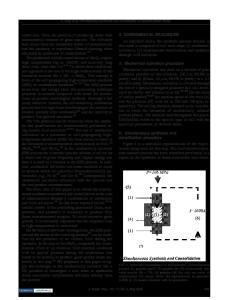Solid-state diffusion-based processing kinetics for uniaxial self-propagating high-temperature synthesis of MoSi 2
- PDF / 804,367 Bytes
- 8 Pages / 598 x 778 pts Page_size
- 103 Downloads / 352 Views
I.
INTRODUCTION
SELF-propagating high-temperature synthesis (SHS), sometimes referred to as combustion synthesis, involves the rapid, irreversible chemical reaction between two or more condensed phases at elevated temperatures to form a solid product phase in consolidated form. Hence, the product phases are refractory almost by definition. Research on this process is driven in part by the need to find a more rapid and less expensive consolidation process than the available alternatives for refractory materials, which are mostly hot pressing and hot isostatic pressing. Self-propagating hightemperature requires a large exothermic heat of reaction, a condition met for many ordered intermetallic compounds. MoSi2 is one of these compounds, with a high melting point and unusually good oxidation resistance, which accounts for considerable interest in SHS formation of this material. While this article deals with SHS of MoSi2, the primary focus will be on modeling the dynamics of reaction propagation as a prototype model for condensed phase SHS reactions generally. The model presented uses process engineering principles, without adjustable parameters, but it differs considerably from the models current in the SHS literature.t~m These have their genesis in the rate theory of homogeneous gas reactions, which were extended into a wave propagation combustion theory of gasest61 and then extrapolated, rather considerably, to the condensed phase reactions of SHS by continuing to assume that solid particles of significant di-
ROBERT W. BARTLETT, Dean, and KEITH A. PRISBREY, Professor, are with the College of Mines and Earth Resources, University of Idaho, Moscow, ID 83844-3025. This article is based on a presentation made in the "In Situ Reactions for Synthesis of Composites, Ceramics, and Intermetallics" symposium, held February 12-16, 1995, at the TMS Annual Meeting in Las Vegas, Nevada under the auspices of SMD and ASM-MSD (the ASM/TMS Composites and TMS Powder Materials Committees) 208~-VOLUME 27A, AUGUST 1996
mension can be approximated as an isotropic homogeneous mixture without involvement of mass diffusion in the process kineticY 1 Typically, in SHS experiments, a powder compact of well-mixed reacting elements is heated to an ignition temperature at which the reaction eventually becomes self-sustaining. As heat is transferred away from the hot reaction locus, the reaction propagates to completion as a combustion wave, often with great rapidity. In the usual cases of interest for synthesizing refractory materials, at least one of the reactants is a solid particle and the product is a solid. Whenever this occurs, a solid product concentric shell must form around the reacting solid grain, and the grain microreaction kinetics at elevated temperatures will usually be governed by the solid-state diffusion process controlling the rate of formation of this solid product shell. MoSi2 is a good example of this phenomenon and is being used as the prototype for a general model for SHS of refractory materials, i.e., materials where
Data Loading...











